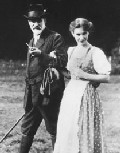Freud in DreamLand

Scene from the film Secrets of a Soul, which was premiered on 24.3.1926 in Berlin

German filmmaker GW Pabst's silent film Geheimnisse einer Seele relates the tale of a professor driven into a state of terror by a dream in which he attempts to stab his wife. To make his exploration of the psychoanalytic theory of the unconscious, Pabst secured the help of two leading analysts from Berlin – Karl Abraham and Hanns Sachs – though Sigmund Freud would have nothing to do with it. Pabst's film, thoroughly Expressionist, is an exploration of the encounter between psychoanalysis and cinema in which psychoanalysis becomes the actual subject of film. Secrets of a Soul presented a case study of phobia, repression and compulsion, and was the first film that represented psychoanalysis as treatment ... essentially a bourgeois melodrama, about a chemistry professor whose frustrated desire to father a child meshes with his jealousy of his wife's childhood sweetheart. The professor's fantasies are, of course, generously illustrated in the remarkable dream sequences, awash with sexual symbols. The deciphering of these dreams as he consults a psychoanalyst is necessarily too pat, but Pabst's aims still look as bold and daring as they must have done in 1926. Superimpositions, symbolic images of razors and knives and menacing shadows create a frightening world. In the film, the tortured professor’s chance meeting with a kindly psychoanalyst (Pawel Pankow) leads to a long period of therapy, through which he eventually gains insight into the unconscious thoughts and motives that were causing his neurosis. Eventually, he is cured, happily returning to the security of a loving marriage.

In 1925 the Hollywood film producer Samuel Goldwyn offered Freud $100,000 if he would collaborate on a "love film" about Anthony and Cleopatra, but in vain. In the same year the film producer Hans Neumann requested the Berlin psychoanalysts Hanns Sachs and Karl Abraham to act as advisers in the making of a "psychoanalytic" film. So popular did psychoanalysis appear to be at this time that even the German film industry viewed it as a topic likely to attract the general public. In spite of Freud's strong objections, Abraham and Sachs accepted the offer and reworked the scenario of the film Secrets of a Soul: A Psychoanalytical Drama (Director: G.W. Pabst, Scenario: Colin Ross). The UFA film reconstructed a case of mental disturbance and its cure by psychoanalysis which Freud had reported. Sachs put together a brochure to accompany the film, under the title "Psychoanalysis. Riddle of the Unconscious", which was intended to explain to the public the basic outline of psychoanalytical therapy.

Scene from Secrets of a Soul: Werner Krauss played the patient, Pawel Pankow the doctor.
Meanwhile in Vienna A. J. Storfer and Siegfried Bernfeld were developing the project of producing a counterpart to Secrets of a Soul for the International Psychoanalytical Press. The attempt of both analysts to enter the film business turned out to be unsuccessful. Their film project failed owing to insufficient support from other psychoanalysts and not least because of lack of capital to finance it. When Freud heard of the film plans of his own press he stressed to Ferenczi his opposition to anything that might connect his name with a film: "Stupid things happen in film affairs. The company that has beguiled Sachs and Abraham could, of course, not restrain itself from proclaiming my "consent" to the world. I remonstrated strongly to Sachs, today the Neue Freie Presse published a denial. Meanwhile it turns out that Bernfeld and Storfer are involved in a similar undertaking. I won't hold them back since filming seems to be as unavoidable, it seems, as page-boy haircuts, but I won't have myself trimmed that way and do not wish to be brought into personal contact with any film." [Freud to Ferenczi, 14.8.1925] To lend his name to a love film, as Goldwyn had suggested, seemed to Freud less of an error than the attempt to film psychoanalysis itself. His main objection against its visual representation remained that "I do not consider it possible to represent our abstractions graphically in any respectable manner." (Freud to Abraham, 9.6.1925). [ A decade later, Freud declined William Randolph Hearst’s offer to come to Chicago “at any price” to analyze the famous murderers, Leopold and Loeb, later portrayed by Hitchcock in Rope].
Enter Hitchcock ...


1 Comments:
Lol!!
[Do you think he might have seen it? ... maybe Burroughs did too]
Post a Comment
<< Home